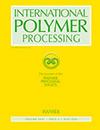Effect of stacking sequence and thickness variation on the thermo-mechanical properties of flax-kenaf laminated biocomposites and prediction of the optimal configuration using a decision-making framework
IF 1.1
4区 工程技术
Q4 ENGINEERING, CHEMICAL
引用次数: 1
Abstract
Abstract The use of naturally derived eco-friendly biocomposites became more popular due to growing environmental concerns and hunt for sustainable materials. Biocomposites can reduce the residual waste and carbon emission to the environment during their lifecycle. The present study aims to develop biocomposites by reinforcing flax fiber (F) and kenaf fiber (K) laminates with bio-epoxy matrix at four different arrangements (FFF, FKF, KFK, and KKK). The biocomposite samples were fabricated with three laminated thicknesses (3 mm, 4 mm and 5 mm) and the thermo-mechanical performance was investigated. The results showed that FFF biocomposites recorded higher tensile, flexural, and interfacial properties with lower density and absorption of water compared to KKK biocomposites due to higher cylindrical lumen diameter of flax laminates. The hybridization of flax with kenaf fiber at different stacking sequences provided greater strength, modulus, toughness, stiffness, thermal stability and degradation behaviour due to greater interfacial interaction between laminated fiber and bio-epoxy. The FKF biocomposites showed maximum impact strength (52.96 kJ/m2), tensile strength (110.21 MPa), and compressive strength (139.64 MPa) at 5 mm laminated thickness while, flexural (158.67 MPa) and shear strength (39.45 MPa) were maximum at 4 mm thickness with the highest degradation temperature (336 °C). The optimal biocomposite configuration has been identified through employability of a novel decision-making framework encompassing interval-valued intuitionistic fuzzy sets, TOmada de DecisaoInterativaMulticriterio (TODIM) and Schweizer–Sklar operations. The inclusive evaluation with regard to the applied framework has revealed that FKF and KFK biocomposites with 4 mm thickness (Lam5 and Lam8) configuration to have the optimal configuration. On the other hand, Lam 10, i.e., KKK_3 mm turned out to be inferior to all the considered biocomposite configurations.铺层顺序和厚度变化对亚麻-红麻层合生物复合材料热力学性能的影响及基于决策框架的最佳构型预测
由于日益增长的环境问题和对可持续材料的追求,天然衍生的生态友好型生物复合材料的使用越来越受欢迎。生物复合材料可以减少其生命周期中对环境的残余废物和碳排放。本研究旨在以四种不同的排列方式(FFF、FKF、KFK和KKK)增强亚麻纤维(F)和红麻纤维(K)层合材料,以制备生物环氧基复合材料。制备了三种层合厚度(3 mm、4 mm和5 mm)的生物复合材料样品,并对其热力学性能进行了研究。结果表明,与KKK生物复合材料相比,FFF生物复合材料具有更高的拉伸、弯曲和界面性能,但密度和吸水性较低,这是由于亚麻层合板的圆柱腔直径较大。亚麻与红麻纤维以不同的堆叠顺序杂交,由于层合纤维与生物环氧树脂之间的界面相互作用更大,从而具有更高的强度、模量、韧性、刚度、热稳定性和降解性能。FKF生物复合材料在层合厚度为5 mm时,冲击强度(52.96 kJ/m2)、抗拉强度(110.21 MPa)和抗压强度(139.64 MPa)最大;在层合厚度为4 mm时,弯曲强度(158.67 MPa)和抗剪强度(39.45 MPa)最大,降解温度为336 ℃。通过一种新的决策框架的可用度,包括区间值直觉模糊集、TOmada de decisiisaointerativamictiiterio (TODIM)和Schweizer-Sklar操作,确定了最佳生物复合配置。对应用框架的包容性评价表明,厚度为4 mm (Lam5和Lam8)的FKF和KFK生物复合材料具有最佳构型。另一方面,Lam 10,即KKK_3 mm被证明不如所有考虑的生物复合结构。
本文章由计算机程序翻译,如有差异,请以英文原文为准。
求助全文
约1分钟内获得全文
求助全文
来源期刊

International Polymer Processing
工程技术-高分子科学
CiteScore
2.20
自引率
7.70%
发文量
62
审稿时长
6 months
期刊介绍:
International Polymer Processing offers original research contributions, invited review papers and recent technological developments in processing thermoplastics, thermosets, elastomers and fibers as well as polymer reaction engineering. For more than 25 years International Polymer Processing, the journal of the Polymer Processing Society, provides strictly peer-reviewed, high-quality articles and rapid communications from the leading experts around the world.
 求助内容:
求助内容: 应助结果提醒方式:
应助结果提醒方式:


